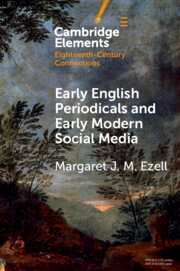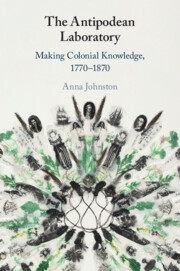105 results
3 - Cultivating Australian Poetry through Periodicals
- from Part I - Change and Renewal
-
-
- Book:
- The Cambridge Companion to Australian Poetry
- Print publication:
- 13 June 2024, pp 54-70
-
- Chapter
- Export citation
Chapter 12 - Early Modern Print Technologies
- from Part III - Cultural Transfers
-
-
- Book:
- Europe in British Literature and Culture
- Print publication:
- 13 June 2024, pp 199-212
-
- Chapter
- Export citation
23 - The Oneiric Golden Age of Gay and Lesbian Pulp
- from Queer Genre
-
-
- Book:
- The Cambridge History of Queer American Literature
- Published online:
- 17 May 2024
- Print publication:
- 06 June 2024, pp 413-425
-
- Chapter
- Export citation

Early English Periodicals and Early Modern Social Media
-
- Published online:
- 23 May 2024
- Print publication:
- 30 June 2024
-
- Element
-
- You have access
- Open access
- HTML
- Export citation
Chapter 11 - Print Culture in the Nineteenth Century
- from Part II - Critical Inroads
-
-
- Book:
- A History of Argentine Literature
- Published online:
- 09 May 2024
- Print publication:
- 16 May 2024, pp 165-183
-
- Chapter
- Export citation
Chapter 2 - 1810: Patriotic Voices
- from Part I - Literary Dates
-
-
- Book:
- A History of Argentine Literature
- Published online:
- 09 May 2024
- Print publication:
- 16 May 2024, pp 24-38
-
- Chapter
- Export citation
‘A sad inheritance of misery’: the cultural life of hereditary scrofula in eighteenth-century England
-
- Journal:
- Medical History / Volume 68 / Issue 1 / January 2024
- Published online by Cambridge University Press:
- 15 March 2024, pp. 1-21
-
- Article
-
- You have access
- Open access
- HTML
- Export citation
16 - Print Culture and Literary Sociology
- from Part IV - Critical Approaches
-
-
- Book:
- The Cambridge Companion to Contemporary African American Literature
- Published online:
- 14 December 2023
- Print publication:
- 21 December 2023, pp 268-282
-
- Chapter
- Export citation
7 - Poet-Essayists and Magazine Culture in the Nineteenth Century
- from Part I - The Emergence of the American Essay (1710–1865)
-
-
- Book:
- The Cambridge History of the American Essay
- Published online:
- 28 March 2024
- Print publication:
- 14 December 2023, pp 114-128
-
- Chapter
- Export citation
Chapter 3 - Freedom’s Conduit
-
- Book:
- Black Women and Energies of Resistance in Nineteenth-Century Haitian and American Literature
- Published online:
- 09 November 2023
- Print publication:
- 23 November 2023, pp 73-99
-
- Chapter
- Export citation
6 - Creating Colonial Readers and Imperial Networks
- from Part III - Inventing Settler Science
-
- Book:
- The Antipodean Laboratory
- Published online:
- 21 September 2023
- Print publication:
- 05 October 2023, pp 212-246
-
- Chapter
- Export citation
Introduction
-
- Book:
- The Antipodean Laboratory
- Published online:
- 21 September 2023
- Print publication:
- 05 October 2023, pp 1-30
-
- Chapter
- Export citation
1 - Morality, Violence and Sentiment
- from Part I - Imagining Settler Humanitarianism
-
- Book:
- The Antipodean Laboratory
- Published online:
- 21 September 2023
- Print publication:
- 05 October 2023, pp 33-65
-
- Chapter
- Export citation
Conclusion
- from Part III - Inventing Settler Science
-
- Book:
- The Antipodean Laboratory
- Published online:
- 21 September 2023
- Print publication:
- 05 October 2023, pp 247-259
-
- Chapter
- Export citation
4 - Prison Letters
- from Part II - Regulating Settler Society
-
- Book:
- The Antipodean Laboratory
- Published online:
- 21 September 2023
- Print publication:
- 05 October 2023, pp 147-178
-
- Chapter
- Export citation
A munshi discussion on religion, and the Simla Akhbār, circa 1850 – ERRATUM
-
- Journal:
- Journal of the Royal Asiatic Society / Volume 33 / Issue 4 / October 2023
- Published online by Cambridge University Press:
- 17 October 2023, p. 1003
- Print publication:
- October 2023
-
- Article
-
- You have access
- HTML
- Export citation

The Antipodean Laboratory
- Making Colonial Knowledge, 1770–1870
-
- Published online:
- 21 September 2023
- Print publication:
- 05 October 2023
A munshi discussion on religion, and the Simla Akhbār, circa 1850
-
- Journal:
- Journal of the Royal Asiatic Society / Volume 33 / Issue 4 / October 2023
- Published online by Cambridge University Press:
- 23 August 2023, pp. 991-1001
- Print publication:
- October 2023
-
- Article
- Export citation
Chapter 9 - Evading Censorship through Comedy, Improvisation, and Non-verbal Performance in the Early Nineteenth Century
- from Part III - Performance
-
-
- Book:
- The Censorship of Eighteenth-Century Theatre
- Published online:
- 03 August 2023
- Print publication:
- 17 August 2023, pp 194-218
-
- Chapter
- Export citation
Chapter 20 - The Communities of The Book of Margery Kempe
- from V - Women as Authors
-
-
- Book:
- Women and Medieval Literary Culture
- Published online:
- 28 July 2023
- Print publication:
- 17 August 2023, pp 420-437
-
- Chapter
- Export citation



